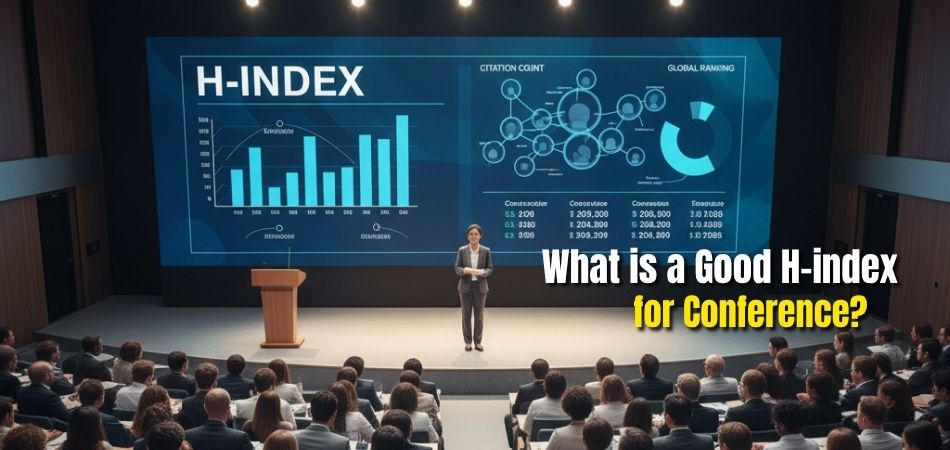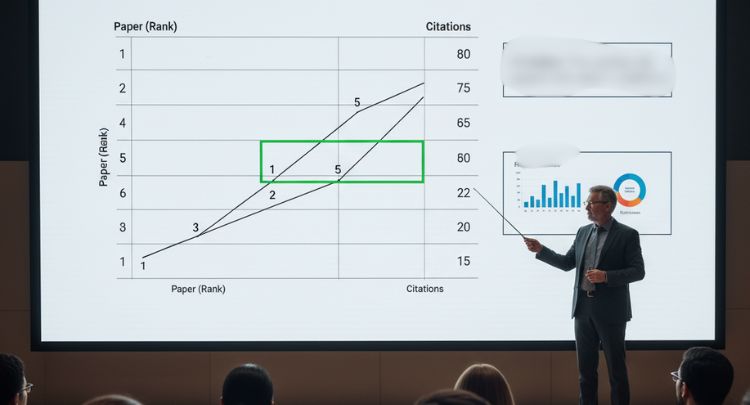Conferences are big meetings where people share new ideas, research, and discoveries. Students, young researchers, and experts all come together to learn and discuss. A common way to measure a researcher’s impact is called the H-index. But can a conference itself have an H-index?
If you are asking what is a good H-index for conference, the truth is that conferences don’t have their own H-index. Instead, the value of a conference is seen through the H-index of the people who attend and present. New researchers often have an H-index around 8–12, while experienced ones may reach 20 or more.
In the rest of this article, we’ll explain what these numbers mean and why they matter.
What is a Good H-index for Conference?
The H-index is a number that shows how often research papers are cited in other works. It helps measure both productivity and the impact of researchers and conferences. This index is not only for people but also applies to journals and conferences. Knowing it makes it easier to judge research quality and find strong venues in a field.
Field Differences Matter
Different subjects have different citation habits, and this changes how high or low the H-index looks. In computer science, papers get cited much faster than in medicine or the humanities, so the scores are usually higher. A strong score in one subject could look weak in another if you compare them directly. That is why conferences should always be compared within the same subject.
Large research communities also make scores grow because more people are writing and citing papers every year. For example, AI has millions of researchers producing highly cited work quickly. Smaller fields like history or philosophy will never reach the same numbers, even if their work is valuable. Looking at the size of the field helps you understand the score better.
Age of the Conference
Older conferences often have higher scores simply because they have been running for many years. A conference that started 40 years ago will naturally collect more citations than one that began 5 years ago. This does not mean the newer conference is weak, only that it needs time to grow. Age is always an important point when comparing scores.
Even so, new conferences can sometimes grow fast if they publish strong and popular research. Many AI and machine learning events rose to the top in less than ten years. This shows that a short history does not always mean low quality. Checking both the history and growth speed is a smart way to judge.
h5-index Versus Full H-index
The h5-index looks only at the last five full years of publications. It shows how strong a conference is right now, making it good for current impact. The full H-index, however, includes all papers from the start, so it shows long-term influence. Both numbers are useful, but they mean different things.
Top conferences in fields like AI can have h5-index values above 200, showing very strong influence. Mid-level conferences are often between 50 and 100, which is still solid. New or small conferences might score below 20, but that does not mean they are bad. Looking at both measures together gives a clearer picture.
Regional and International Context
Where the conference is held also makes a difference in visibility and citations. The United States, the United Kingdom, and Germany host many top academic events every year. Canada also hosts respected international events, and exploring conferences in Canada, along with other regions, can help researchers find the right place to publish. The mix of countries matters when judging global reach.
Regional culture and funding also change how well a conference is known. European conferences sometimes attract mixed fields, leading to many cross-disciplinary citations. Asian conferences often focus on applied technology, which brings a strong impact in the industry. These regional styles add more context to the meaning of the H-index.
Ranking Systems and Benchmarks
Different ranking systems help researchers understand where a conference stands compared to others. Google Scholar Metrics lists h5-index values and allows you to see the top events by field. Scimago provides full H-index numbers, which show long-term historical impact. Some ranking systems also group conferences into classes, like A1 to B5.
These rankings are useful, but they should always be read with care. A score that looks very good in one subject could look average in another. Benchmarks are not fixed numbers but depend on where the conference belongs. Comparing with direct peers is always better than comparing across fields.
Practical Use of H-index
Researchers often check H-index values before choosing where to publish. A high number means the conference is widely read, which helps papers gain attention. This can also help a researcher’s career grow faster, since visibility matters for grants and jobs. Institutions use the same numbers when judging quality.
However, H-index is not the only thing that matters. A smaller conference may offer better chances to meet experts in the same area. Some conferences focus on building networks and sharing ideas more than chasing citations. A balanced choice looks at both numbers and personal goals.
How Do H-index Norms Differ Between Conferences and Journals?
The h-index norm differs between conferences and journals primarily due to differences in publication and citation practices:
- Journals typically have higher h-indices than conferences because journal articles often receive more citations and have longer lifespans for citations to accumulate. Journals tend to publish more comprehensive and polished research, resulting in more citations per article.
- Conferences often have lower h-indices since conference papers are usually preliminary or shorter reports and may have less visibility or fewer citations overall. Conference papers tend to be cited less frequently than journal articles and may focus more on emerging or specialized research topics.
- Citation accumulation also differs as conferences have faster turnover and often focus on cutting-edge or niche topics, while journals contribute to more established streams of research that receive citations over longer periods.
- Metrics like h-index for conferences usually reflect smaller citation bases and may emphasize recent productivity and impact, such as using a 5-year h5-index to capture recent conference impact.
In sum, journals generally have higher and more stable h-index norms than conferences due to differences in citation patterns, publication scope, and research dissemination timing. Conference h-indices are often lower but important for indicating emerging and cutting-edge research impact.
How is the H-index Calculated for Conferences?
The h-index helps show how strong research work looks by counting citations. Conferences and journals both use it, but differently. Knowing these differences gives better clarity when comparing academic impact between the types of publication sources.
Conference Paper Variety
Conferences gather many short papers, posters, and technical notes, which lowers citation growth compared to long journal studies. Journals usually publish fewer but longer studies that attract a broader readership. The variety in conference output affects how quickly citations accumulate. This variety creates different citation patterns that influence h-index measurements.
Review and Selection
Conference papers often pass through quicker reviews focused on novelty, speed, and emerging relevance. Journal papers undergo longer reviews with deeper analysis. This difference changes citation speed because journals often publish more mature studies. Conferences may achieve early attention, while journals build influence steadily over time.
Citation Lifespan
Conference papers generally peak early in citation growth because of their fast exposure at large events. Journal articles remain influential longer due to broader circulation and reference use. The lifespan difference shapes h-index trends for both platforms significantly. Early impact dominates conferences, while long-term impact defines journals.
Audience Size
Conferences target specialized audiences, often smaller communities interested in new developments within narrow fields. Journals often reach wider academic groups across broader disciplines. Audience size directly changes how often research gets cited. Wider exposure gives journals an advantage for building larger citation numbers overall.
Field-Specific Behavior
Computer science and engineering often give more weight to conferences, making their h-index values comparable to journals. In medicine, psychology, and biology, journals dominate as primary publication outlets. Field expectations decide where higher influence usually appears. Comparing h-index values must always consider specific disciplinary practices.
Influence of Rankings
Global rankings influence whether scholars choose conferences or journals for their research. Rankings shape visibility, reputation, and long-term recognition. The impact of rankings on conference quality often guides institutional choices for promotions or grant support. Knowing ranking influence explains why h-index values differ so widely.
Common Misunderstandings About the H-index
Many people hear the word “H-index” but do not really understand what it fully means. Some think it is only about how many papers someone writes, which is not correct. Others believe bigger numbers always mean better researchers, but that is also not true. Let’s clear up some of these common misunderstandings in a simple way.
Only About Quantity
A lot of people assume the H-index is only about writing a large number of papers. The truth is, it also depends on how many times those papers are cited by other researchers. Someone can write many papers, but still have a low score. The index shows a balance between productivity and influence.
Always Shows Quality
Some think the H-index always proves the quality of someone’s work, but that is not right. A paper may get cited often, but not always because it is excellent. Sometimes it gets cited for errors or because it is easy to reference. So, citations alone do not always equal high quality.
Same in Every Field
Another common mistake is thinking the H-index means the same in every subject or field. Different fields have different research sizes and citation habits, which change the average scores. For example, computer science often has higher values compared to history. It is important to compare people within the same subject.
Higher Means Better
Many believe a higher H-index always means one researcher is better than another, but that is misleading. A young researcher may have a lower score simply because they started later. Older researchers have more years to gather citations. Context matters more than just the number itself.
Works for Conferences Too
Some also think conferences cannot have an H-index, but they can. It is calculated from the number of papers presented and how often they are cited. This shows the overall influence of the conference over time. Still, it should not be compared directly with individuals.
How Researchers Can Use H-index When Choosing a Conference?
Choosing the right conference is an important decision for every researcher. The H-index offers one way to measure influence. By looking closely at numbers and relevance, researchers can decide where their work will shine best. Here are more ways researchers can use the H-index in choosing a conference:
Prestige and Impact
- Conferences with higher H-index values usually hold stronger reputations across the academic community. Presenting work there can build lasting recognition.
- Attending high-ranked conferences helps researchers network with experts and peers. These connections often lead to collaborations and further citations.
- Publishing in prestigious venues often boosts professional credibility. Strong visibility from such places can make a long-term difference.
Career Goals Alignment
- Researchers must match their goals with conference levels. Bigger goals may require aiming for conferences with larger H-index values.
- Someone seeking recognition may prefer top venues. These events highlight the research globally and raise the author’s academic profile quickly.
- Those working toward advancement often choose high-ranked venues. Doing so aligns with long-term objectives and institutional promotion standards.
Field Relevance
- Different fields show varied H-index averages, making subject-based benchmarks crucial. Researchers should compare conferences only within related disciplines.
- Computer science events often display higher values than the humanities. Each field grows at a different speed, influencing scores differently.
- Researchers gain the most by selecting subject-specific events. That way, their work reaches audiences genuinely interested in their contributions.
Career Stage Choice
- Early researchers may target moderate H-index conferences. These provide opportunities for recognition without heavy competition from senior experts.
- Experienced scholars usually aim for top-tier venues. This maintains their influence and increases professional visibility across the community.
- Each stage requires a different focus. Recognizing these needs ensures growth, recognition, and proper alignment with academic progress.
Ranking Influence
- Rankings give another view of conference reputation. Many systems categorize venues differently, influencing how researchers choose their submissions.
- The significance of the A and A* ranking often guides choices, especially when grants or promotions are considered.
- Looking at rankings alongside H-index values helps researchers. It provides both numerical impact and relative reputation across various disciplines.
Database Coverage
- Checking resources like Google Scholar or Scopus gives better clarity. These sources list H-index values for many academic venues.
- Reliable data ensures informed decisions. Without accurate figures, researchers may submit to events with weaker citation visibility.
- Evaluating multiple sources reduces bias in results. This makes sure the researcher selects conferences with trustworthy citation recognition.
FAQs about Good H-index for Conference
The H-index for conferences often raises many questions among researchers and students. It reflects impact, but the meaning changes depending on field, career stage, and goals. Here are some common questions with clear answers to help you understand better.
How Do Smaller Conferences Show Their H-index Value?
Smaller conferences usually display lower H-index values because of limited papers and fewer citations. However, these values can still be meaningful. For specialized fields, even a modest H-index shows important recognition within a smaller research community.
Does The Size Of A Research Community Affect Conference H-index?
Yes, community size makes a big difference. Larger fields like computer science or biology naturally gain more citations, boosting H-index numbers. Smaller fields with fewer researchers may record lower values, but those numbers can still reflect significant influence within their subject.
Why Do Older Conferences Often Have Higher H-index Scores?
Older conferences usually collect more citations because they’ve been active longer. With more years of published papers, their citation counts steadily increase. This naturally raises the H-index, even though newer conferences may also provide high-quality, innovative research opportunities.
Can Conference Format Influence The H-index Score?
Yes, format plays a role. Conferences that publish full research papers generally attract more citations than those with abstracts only. Full papers are easier to reference in future studies, which directly boosts the H-index of that conference.
Are All Citation Databases Equal For Measuring H-index?
No, citation databases differ in coverage. Google Scholar, Scopus, and Web of Science include different sets of conference papers. A conference may appear stronger in one database than another, so researchers should compare across multiple platforms.
Do Interdisciplinary Conferences Show Reliable H-index Scores?
Interdisciplinary conferences often have mixed citation patterns because they cover many subjects. Their H-index may appear lower compared to field-specific events. Still, they provide valuable visibility since research reaches wider audiences, even if citation numbers spread unevenly across disciplines.
How Can Early-Career Researchers Benefit From Mid-Tier H-index Conferences?
Mid-tier conferences offer recognition without overwhelming competition from top-level experts. For early-career researchers, presenting there builds confidence and credibility. These venues also help them secure citations, feedback, and collaboration opportunities, laying a foundation for stronger future academic achievements.
Is Comparing H-index Across Different Disciplines A Good Practice?
No, comparing across disciplines is misleading. Each subject has different research sizes, citation practices, and publication patterns. A conference in physics may naturally have a higher H-index than one in philosophy, but both can be equally respected in their fields.
Final Words
Conferences help researchers share ideas and grow in their careers. The H-index is one way to see how strong or well-known a conference is. But numbers alone do not tell the full story.
Many things affect this, like the field of study, how old the conference is, and where it is held. So, when people ask what is a good H-index for conference, there is no one right answer. It depends on the goal, subject, and level of the researcher. Always look at both the number and the purpose before choosing where to present your work.








